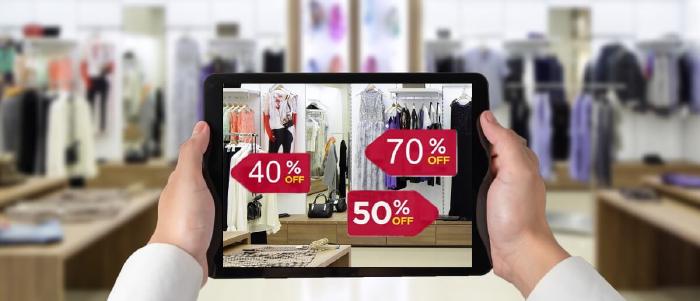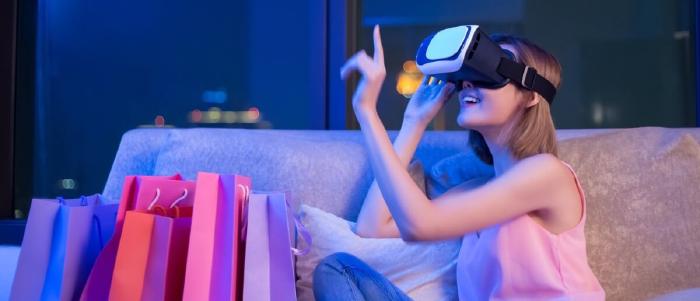
Sep 23 2022
7 min read

If you are a retailer, you must already know what is visual merchandising and how it impacts consumer psychology.
According to research, 93% of shoppers consider visual impressions while purchasing a product. Successful retail businesses invest millions in creative visual merchandising to ensure that customers enjoy the store experience and that the store’s unique identity is ingrained in their memory.
And, it is not just the blue-blooded luxury brands that design their stores on visual merchandising principles; your local supermarket is equally attentive to this. Why else do you think we end up carrying a few things in our cart every time we go to the supermarket that we did not intend to buy? (Don’t say you don’t 😉)
The ultimate objective of retail visual merchandising is to convince customers that what they see inside the store is what they need. But modern consumers have an elusive mind and a rather sharp sensitivity to repetition. That is why most merchandisers tend to keep track of the latest retail visual merchandising trends.
What new technology are other competing retail brands using?
Why a particular visual merchandising design suddenly goes viral?
Is there a gradual shift happening in the consumer’s intent? What do they like these days?
And questions as such. The answers to these questions can be found when you follow the trends and keep and learn from the industry trendsetters.
In this blog, we have listed some of the top visual merchandising trends and some examples of retail brands that have done a fantastic job with visual merchandising and store design. Let’s get started!
Since visual merchandising is all about visuals, there is no point elaborately discussing it in theory. While there are so many brands doing visual merchandising in their own unique way, we have picked some examples that you can also learn from. Read on.

The Seed Store in Melbourne Emporium is one of the most outstanding examples of fashion store visual merchandising. The store’s design, color, and lighting do fabulous justice to the retail brand’s monochrome theme.
With color minimalism, and enough breathable room for the customers to walk around, the store offers a calmingly pleasant experience. The light wooden texture of the flooring and walls contrasts with the beige curtains and sharp black & white fixtures, lights, furnishings, and even the apparel on display.
The central pod is a unique visual merchandising trick that the retailer uses to offer a ‘store-within-store’ experience; it instantly draws the customers’ attention toward the best products.
Key Takeaway: Your retail store visual merchandising must be aligned with the retail brand’s voice and theme.

Quite contrasting to the SEED store, Zara Home Stores embraces Maximalism in their creative visual merchandising. Maximalism doesn’t mean stuffing a space with the maximum number of objects; it means using objects for storytelling.
Just like every home has a feeling and a story inside it, the Zara Home Store Sets put together all the lifestyle essentials and gives the customer a visual sense of how it will appear in their homes.
One of the eccentricities of Zara’s retail visual merchandising sets is the table designs. Objects aesthetically clutter the table giving a ‘real-life’ feel.
Key Takeaway: Disorder and unconventional visual merchandising can also appear welcoming if it helps your store communicate a story effectively.

Another fashion retail brand, Stella McCartney aced visual merchandising with digital signage platforms. For its Spring-Summer 2018 collection, the retail brand installed a mesmerizing array of video walls on its store windows.
While the mannequins wore pieces from the collection, the mosaic of hanging displays played high-definition content that clearly advocated the brand’s ultra-modern posh city-life leitmotif.
With warm interior lighting and minimum spotlight on the mannequins, the visual merchandising of the store uses the digital signage screen light to capture the passerby’s attention.
Key Takeaway: When done right, digital signage can be a powerful tool for retailers; it can show marketing videos and improve your store aesthetics at the same time.
The US-based fashion house Coach New York took storefront visual merchandising to a whole new level with its 3D immersive installations. The dynamic 3D displays create a larger-than-life experience as the brand mascot Rexy virtually jumps out of the window with the brand’s products in its mouth.
The playfulness is more than exhilarating. It shatters the dilemma in passersby’s minds, and people are tempted to enter the store for the sheer retailtainment.
After all, who doesn’t love a friendly little T-rex for a sales clerk!
Key Takeaway: If you can afford to go big, go big. And spend some extra bucks to make especially your window displays stand out. Doing the window display visual merchandising right is crucial.
Also read: Visual merchandising window display guidefor retail store’s

Walmart’s key competitor, Whole Foods Market, revolutionized visual merchandising with its flagship store in Austin, Texas. The supermarket store design is less like a retail store and more like a civic center.
The supermarket houses an indoor food bar, a live music podium, and outdoor dining.
Talk about retailtainment, huh?
Despite housing a mammoth volume of products, the retail store doesn’t overwhelm the customers; the store layout skillfully separates each department leaving enough room for the customer to roam around. Signage deployed at strategic locations also guide the shoppers from one department to the other.
The visual merchandising of this super-cool supermarket also focuses on winning the hearts of the locals with local music and signage that represent the love for the city. This allows the supermarket chain to maintain the home-boy identity in every place.
Key Takeaway: Including retailtainment is a must while designing your store’s visual merchandising. The use of digital screens can create a favorable ambiance through our visual and auditory senses.

The Tokyo Comme des Garçons store is all about logos. Yes, the theme of this fashion store’s visual merchandising is the CDG logo, and that’s quite apparent from the above image.
The theme is so because this particular store is dedicated to selling CDG’s logo apparel. Besides making the store theme obvious with the large ‘CDG’ letters in series, the visual merchandisers have also matched the dominant product color: black.
The low-height ceiling with white lights gives the store interior gives shoppers a sense of confidence when they walk in. It is precisely what the retail brand’s logo products are meant to be.
Key Takeaway: It is important to consider your consumer demographic while designing the visual merchandising of any retail store, especially a fashion retail outlet. CDG’s logo products mainly appeal to the younger gym-going, sporty and urban crowd. That is why their store design invoked a sense of confidence & self-assertiveness.
The following are the top three visual merchandising trends that will see a rapid adoption by many retail brands in 2022 and the coming years:
Modern shoppers do not want to enter a store and waste their time being confused about products, store navigation, and other information. That is why if you now go to a store, you will see different types of signage assisting you at every step.
Many of these retail brands are using digital screens to amplify their productivity. After all, why not? Digital signage has multi-pronged applications. Retail displays can run offers & promotions, help customers find their way through the store, show product details on virtual product catalogs, and much more.
In this age of always-accessible information, retailers stand to lose substantial business if information is not readily available to their customers.
There is no domain left where technology is yet to shower its blessings. Interactive displays, in particular, are nowadays a rage. Touchscreen and touchless technology in digital signage help retail customers get personalized and filtered information.
Interactivity also allows more engagement with the brand. For example, retail brands can launch exciting digital discount coupons with a simple QR code on the screen, and this can prompt the shoppers to make an additional purchase (often called impulse purchase).
From QR codes on digital screens, to interactive self-check-out kiosks to high-tech Augmented Reality (AR) technology, interactivity is quickly becoming a must-have component of many retail visual merchandising trends.
We can all agree we are discussing sustainability these days much more than we did a decade ago. Whether it’s going paperless or using recycled material in our designs, the idea of sustainability permeates in one way or the other.
More and more organic and vegan brands are replacing the traditional retailers, and they are eager to express their conviction through sustainable visual merchandising designs. The customers laud it too.
Visual merchandisers now utilize sustainable materials like clay, used plastic, metal scraps, and gravel to design mannequins, flooring, artefacts & window displays.
Irrespective of the scale of your retail business, visual merchandising is a key strategy that you need to implement. The best way to do visual merchandising work is to do your homework right: see what top brands are following and understand the customer demography and customer needs. And the most important thing is to keep updating your retail store with new and upcoming designs, technologies & solutions.


Sep 23 2022
7 min read
![What are 3D digital billboards for advertising? [5 Examples]](/blog/images/3d-advertising-billboard/banner_hu3a52995533a2f5f6af3321531a883f0d_86539_700x0_resize_q75_box.jpg)
Sep 8 2022
6 min read

Sep 6 2022
9 min read

Aug 18 2022
6 min read
Take complete control of what you show on your digital signage & how you show it.
Start Free Trial Schedule My DemoSee How Amazon Solved Retail Marketing Challenges – Boosted Sales & Conversions by Almost 27%
Unlock Exclusive Insights